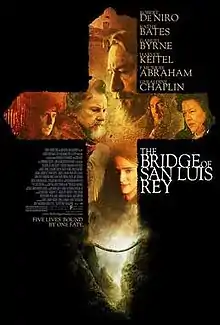The Bridge of San Luis Rey (2004 film)
The Bridge of San Luis Rey is a 2004 drama film directed by Mary McGuckian and featuring an ensemble cast. It is based on Thornton Wilder's novel of the same name. The film was released in 2004 in Spain and 2005 in the U.S. and abroad. Despite praise for its costume design, the film was poorly received by critics.[1]
| The Bridge of San Luis Rey | |
|---|---|
 Promotional poster | |
| Directed by | Mary McGuckian |
| Produced by | Michael Cowan Samuel Hadida Howard G. Kazanjian Garrett McGuckian Mary McGuckian Denise O'Dell |
| Written by | Mary McGuckian |
| Based on | The Bridge of San Luis Rey by Thornton Wilder |
| Starring | |
| Music by | Lalo Schifrin |
| Cinematography | Javier Aguirresarobe |
| Edited by | Kant Pan |
| Distributed by | Fine Line Features |
Release date |
|
Running time | 120 minutes |
| Country | France Spain United Kingdom |
| Language | English |
| Budget | $24 million |
| Box office | $1.8 million |
Synopsis
The film centers on a basic premise: near Lima, Peru, at noon of Friday, 20 July 1714, a bridge woven by the Incas a century earlier collapsed at that particular moment, while five people were crossing it: Doña María, the Marquess of Montemayor; Pepita, her lady in attendance; Esteban, a scribe; Uncle Pío; and a young child. The collapse was witnessed by Brother Juniper, a Franciscan friar, who was on his way to cross it. Curious about why God would allow such a tragedy, he decides to take a scientific approach to the question. He set out to interview everyone he can find who knew the five victims. Over the course of six years, he has managed to compile a huge book, coming to the question whether we live our lives according to a plan or if there is no such thing as a bigger scheme.
Background and production
The film and novel are very loosely based on the life of Micaela Villegas (1748–1819), a famous Peruvian entertainer known as La Perricholi, whose life was also the inspiration for the novella Le Carrosse du Saint-Sacrement by Prosper Mérimée, an opéra bouffe, La Périchole by Jacques Offenbach, Jean Renoir’s 1953 film Le Carrosse d'or (The Golden Coach), and two earlier film versions: a 1929 silent version, The Bridge of San Luis Rey (1929) starring Lili Damita, and a 1944 version, The Bridge of San Luis Rey starring Lynn Bari, Francis Lederer, Akim Tamiroff, and Alla Nazimova.
The 2004 film was shot on location in Málaga, Andalucía, and Toledo, Castilla-La Mancha, Spain. It is the only one of the three versions made on location, and the only one to use the novel's original, shocking ending.
Cast
- F. Murray Abraham as the Viceroy of Peru
- Kathy Bates as the Marquesa
- Gabriel Byrne as Brother Juniper
- Geraldine Chaplin as the Abbess
- Robert De Niro as the Archbishop of Lima
- Émilie Dequenne as Doña Clara
- Adriana Domínguez as Pepita
- Harvey Keitel as Uncle Pio
- Pilar López de Ayala as Micaela Villegas (La Perichole)
- John Lynch as Captain de Alvarado
- Mark Polish as Manuel
- Michael Polish as Esteban
- Jim Sheridan as The King of Spain
- Dominique Pinon as His Excellency's Fop
Reception
The film was panned on release. On Rotten Tomatoes, the film has an approval rating of 4% based on reviews from 24 critics. The site's consensus states: "Despite an all-star cast and some impressive visuals, The Bridge of San Luis Rey is a lifeless, slow-going adaptation of Thornton Wilder's classic novel."[2]
Stephen Garrett of Time Out wrote, "Why do good actors pop up in bad movies? More perplexingly, why do so many good actors end up in the same bad movie?',[3] and Desson Thomas of The Washington Post wrote, "Even though director-adaptor Mary McGuckian expended much creative energy trying to pump original spirit into the characters, she never brings any of them to life."[4]